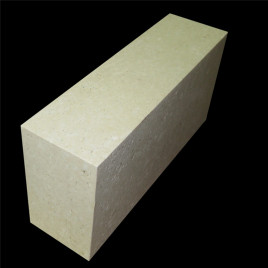Zirconium corundum brick is a refractory brick made of industrial alumina and zircon sand. According to the manufacturing process, zirconium corundum bricks can be divided into fused zirconium corundum bricks and fired zirconium corundum bricks.
Fused zirconium corundum bricks are commonly called white iron bricks, also known as corundum-oblique zircon bricks. The main chemical composition is Al2O3 50%~70%, ZrO2 20%~40%, and the rest is SiO2. The main mineral composition is zircon (ZrO2), corundum (α-Al2O3) and glass phase. Oblique zircon crystals form the backbone of the brick body. ZrO2 has a high melting point (2715°C) and good chemical stability. It has strong corrosion resistance to acidic and alkaline media, especially molten glass.
Fused zirconium corundum bricks are used in industrial furnaces such as glass melting furnaces. The use parts in glass melting furnaces are the masonry of the upper pool wall, small furnace flat casters, small furnace stacks, tongue casters and breast walls. The following issues should be paid attention to in the use of fused zirconia corundum bricks:
① Irregular changes in thermal expansion. The expansion curve of the fused zirconia corundum brick has an abnormality near 1000℃. The internal Zr02 crystal undergoes a reversible crystal transformation and has a large volume change. Therefore, bricks containing ZrO2 should not be used at temperatures around 1000℃. Parts of sharp fluctuations. When baking the kiln, the temperature change should not be too large at 900~1150℃, generally not more than 15℃/h, and the temperature should be raised steadily. Some parts should be protected from cold wind and other bricks should be used to protect them from explosion.
② Shrinkage. During casting, shrinkage holes often appear at the nozzle, where the brick body has more pores and poor density. Therefore, when laying the glass melting pool wall, the shrinkage holes are directed toward the inside of the kiln. If the sprue is facing outwards, when the brick body erodes very thin, it will cause glass leakage accident. When used in the upper flame space of the kiln, the service life is very long, and there will be no problem of running glass. Therefore, the sprue is used to extend the service life.
③ Eutectic. When the fused zirconia corundum bricks and clay bricks are in contact with the masonry, eutectic will occur at a high temperature of 1300℃. Therefore, when selecting refractory materials, avoid contacting the two refractory materials with serious eutectic phenomenon, such as silica bricks. Below the fused zirconia corundum bricks, the most vulnerable to corrosion.
Sintered zirconium corundum bricks are also called ceramic bonded aluminum silicon zirconium bricks. Compared with fused zirconia corundum bricks, sintered zirconia corundum bricks have similar chemical composition, but have the advantages of no carbon, low glass phase content, uniform structure, no shrinkage, thermal shock stability and good corrosion resistance. .
Post time: Nov-07-2020


